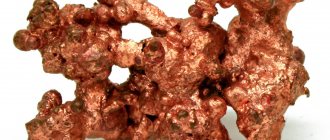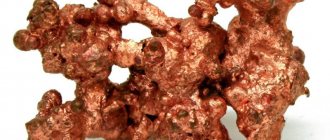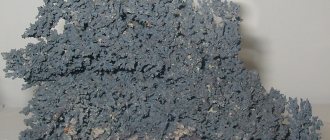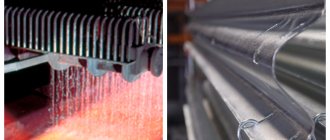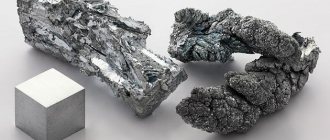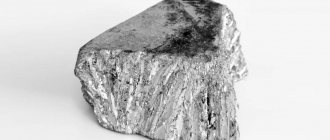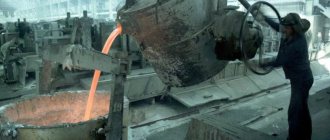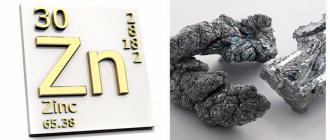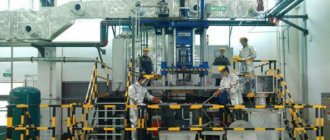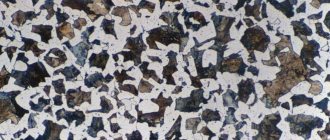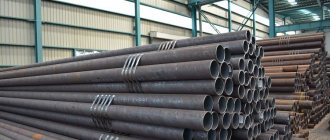The chemical properties of most elements are based on their ability to dissolve in aqueous media and acids. The study of the characteristics of copper is associated with a low-active effect under normal conditions. A feature of its chemical processes is the formation of compounds with ammonia, mercury, nitric and sulfuric acids. The low solubility of copper in water is not capable of causing corrosion processes. It has special chemical properties that allow the compound to be used in various industries.
Item Description
Copper is considered the oldest metal, which people learned to mine even before our era. This substance is obtained from natural sources in the form of ore. Copper is an element of the chemical table with the Latin name cuprum, the serial number of which is 29. In the periodic table it is located in the fourth period and belongs to the first group.
The naturally occurring substance is a pink-red heavy metal with a soft and malleable structure. Its boiling and melting point is more than 1000 °C. Considered a good guide.
Historical reference
Copper is one of the most important elements of antiquity. Copper, gold , silver and tin were the first metals that humanity recognized in its historical development. Because copper is easily processed, it was used by ancient cultures more than 10,000 years ago. The time of widespread use of copper began in the 5th millennium BC. to the 3rd millennium BC
However, in its pure form, copper turned out to be relatively soft for the production of weapons and tools. Therefore, ancient people, through experiments, adding pieces of lead and tin to molten copper, obtained bronze. It is a much harder material than unalloyed copper. Bronze has been used by humanity for over 5,000 years. This alloy gave its name to an entire historical era.
In alchemy, copper was associated with Venus (femininity). Of course, not least because the first mirrors used by women were made of this metal.
Chemical structure and properties
If you study the electronic formula of a copper atom, you will find that it has 4 levels. There is only one electron in the 4s valence orbital. During chemical reactions, from 1 to 3 negatively charged particles can be split off from an atom, then copper compounds with an oxidation state of +3, +2, +1 are obtained. Its divalent derivatives are most stable.
In chemical reactions it acts as a low-reactive metal. Under normal conditions, copper has no solubility in water. Corrosion is not observed in dry air, but when heated, the metal surface becomes covered with a black coating of divalent oxide. The chemical stability of copper is manifested under the action of anhydrous gases, carbon, a number of organic compounds, phenolic resins and alcohols. It is characterized by complex formation reactions with the release of colored compounds. Copper has slight similarities with alkali group metals due to the formation of monovalent derivatives.
It's interesting to know
1. When comparing the properties of copper and alkali metals, a logical question arises: why, given the same type of electronic configuration of the external energy level (for example, 4s1 for K and Cu atoms), are the properties of copper and alkali metals so different? The fact is that the orbital radius of the copper atom (0.119 nm) is significantly smaller than that of potassium (0.216 nm), and the nuclear charge is greater. Therefore, the 4s1 electron in a copper atom is more strongly attracted to the nucleus than in a potassium atom; Accordingly, the first ionization energy of the copper atom (745.4 kJ/mol) is significantly higher than that of the potassium atom (418.8 kJ/mol). However, the second and third ionization energies for copper (1957.9 and 3554 kJ/mol, respectively) are significantly lower than those for potassium (3070.1 and 4.4*103 kJ/mol, respectively), i.e., in the copper atom there are 4s- and 3d electrons are close in energy. This is explained by removing electron(s) from an ion with an electron configuration. 3s23p63d10 (Cu+) is lighter than from an ion with an electron configuration. 3s23p6 (K+). Therefore, unlike alkali metals, copper in compounds can exhibit oxidation states +2, +3 and even + 4.
2. No less interesting is the question of the reasons for the difference in the chemical activity of copper and zinc - metals belonging to the same family, neighbors on the periodic table. The values of the double ionization energy of zinc atoms (1733.3 kJ/mol) are slightly less than those of copper (1957.9 kJ/mol), however, the enthalpy of atomization for zinc (130.5 kJ/mol) is almost three times less than for simple copper substances (339.0 kJ/mol). In other words, the zinc atoms in its crystal are less strongly bonded to each other, which determines the greater chemical activity of the simple substance (not an atom!) of zinc compared to the simple substance copper.
3. When purifying copper using the electrolytic method, the cathode is a sheet of pure copper, the anode is a blank of crude (blister) copper, and the electrolyte is a CuSO4 solution. During electrolysis, the anode dissolves:
Сu0 - 2е ( Cu2+ and copper deposits on the cathode:
Сu2+ - 2е ( Cu0.
In this way, high-purity copper is obtained, containing up to 99.8% copper by weight.
4. For copper in the oxidation state +3, the compounds Cu2O3, (an acidic oxide), K3[CuF6], КCuО2, K[Cu(OH)4], etc. are known. A compound in which the oxidation state of copper is +4 is described: Cs2 [CuF6].
5. Let us explain the reason for the dissolution of copper in hydrohalic acids. The fact is that the electrode potential of the Cu+/Cu system depends on the concentration of Cu+ ions as follows: the lower the concentration of Cu+ ions, the more the electrode potential shifts towards negative values. The formation of a very stable complex H[CuCl2] reduces the concentration of Cu+ ions so much that the electrode potential of the Cu+/Cu system shifts towards negative values and the oxidation of copper atoms by H+ ions becomes possible.
6. The high tendency of copper to form complex compounds is explained by the presence in its atom of vacant and close in energy 4p and 4d orbitals. When a chemical bond is formed, copper usually serves as an electron acceptor, and molecules or ions with lone pairs of electrons (H2O, NH3) serve as electron donors. However, complex compounds are known in which copper, due to lone pairs of electrons in the 3d orbitals, is an electron donor.
7. Copper (I) sulfate can be obtained at 200°C by the reaction:
2Cu + 2H2SO4 ( Cu2SO4 + SO2( + 2H2O.
This salt is stable in air, but decomposes with water into Cu2SO4 and Cu (disproportionates).
What is solubility?
This is the process of formation of homogeneous systems in the form of solutions when one compound interacts with other substances. Their components are individual molecules, atoms, ions and other particles. The degree of solubility is determined by the concentration of the substance that was dissolved when obtaining a saturated solution.
The unit of measurement is most often percentages, volume fractions or weight fractions. The solubility of copper in water, like other solid compounds, is subject only to changes in temperature conditions. This dependence is expressed using curves. If the indicator is very small, then the substance is considered insoluble.
Application of copper and its compounds
Due to its high thermal and electrical conductivity, copper is used in large quantities to make electrical wires, cables, boilers, stills, etc.
Copper alloys find a wide variety of applications. Brass (contains up to 45% zinc) is used for the manufacture of radiators, parts of watch mechanisms, and in shipbuilding. Copper-nickel alloys are used in the energy industry, shipbuilding, for the manufacture of thermocouples, and resistance stores. The main purpose of bronze (contains tin or aluminum) is to make bells and statues.
Copper compounds have found the following applications:
Cu2O - as an AC rectifier.
CuO - as an oxidizing agent in laboratory technology, in the production of glass and enamels, as a green and blue dye.
СuSO4 - as a desiccant; СuSO4 • 5Н2О - copper sulfate - for controlling agricultural pests, when impregnating wood to prevent rotting.
(CuOH)2CO3 - for the production of blue and green paints, as an ornamental stone (in the form of malachite).
Solubility of copper in aqueous media
The metal exhibits corrosion resistance when exposed to sea water. This proves its inertness under normal conditions. The solubility of copper in water (fresh) is practically not observed. But in a humid environment and under the influence of carbon dioxide, a green film forms on the metal surface, which is the main carbonate:
Cu + Cu + O2 + H2O + CO2 → Cu(OH)2 · CuCO2.
If we consider its monovalent compounds in the form of salts, then their insignificant dissolution is observed. Such substances are subject to rapid oxidation. The result is divalent copper compounds. These salts have good solubility in aqueous media. Their complete dissociation into ions occurs.
Receipt
Copper(I) oxide can be prepared:
- heating copper metal in the absence of oxygen
4Cu + O2 →>200∘C 2Cu2O
- heating copper metal in a stream of nitric oxide (I) or nitric oxide (II)
2Cu + N2O →500−600∘C Cu2O + N2 4Cu + 2NO →500−600∘C 2Cu2O + N2
- heating copper metal with copper(II) oxide
Cu + CuO →1000−1200∘C Cu2O
- thermal decomposition of copper (II) oxide
4CuO →1026−1100∘C 2Cu2O + O2
- heating copper(I) sulfide in a stream of oxygen
2Cu2S + 3O2 →1200−1300∘C 2Cu2O + 2SO2
In laboratory conditions, copper (I) oxide can be obtained by reducing copper (II) hydroxide (for example, with hydrazine):
4Cu(OH)2 + N2H4 ⋅ H2O →100∘C 2Cu2O ↓ + N2↑ + 7H2O
Also, copper(I) oxide is formed in ion exchange reactions of copper(I) salts with alkalis, for example:
- in the reaction of copper (I) iodide with a hot concentrated solution of potassium hydroxide
2CuI + 2KOH ⟶ Cu2O↓ + 2KI + H2O
- in the reaction of hydrogen dichlorocuprate (I) with a dilute solution of sodium hydroxide
2H[CuCl2] + 4NaOH ⟶ Cu2O↓ + 4NaCl + 3H2O
In the last two reactions, a compound with a composition corresponding to the formula CuOH (copper (I) hydroxide) is not formed. The formation of copper (I) oxide occurs through an intermediate hydrate form of variable composition Cu2O ⋅ xH2O.
- Oxidation of aldehydes with copper (II) hydroxide. If an aldehyde solution is added to the blue precipitate of copper (II) hydroxide and the mixture is heated, then a yellow precipitate of copper (I) hydroxide appears first:
R−CHO + 2Cu(OH)2 →t R−COOH + 2CuOH↓ + H2O upon further heating, the yellow precipitate of copper (I) hydroxide turns into red copper (I) oxide: 2CuOH →tCu2O + H2O
Solubility of copper in nitric acid
This reaction is possible due to the fact that the process of oxidation of the metal with a strong reagent occurs. Nitric acid in diluted and concentrated form exhibits oxidizing properties with the dissolution of copper.
In the first option, the reaction produces copper nitrate and nitrogen divalent oxide in a ratio of 75% to 25%. The process with dilute nitric acid can be described by the following equation:
8HNO3 + 3Cu → 3Cu(NO3)2 + NO + NO + 4H2O.
In the second case, copper nitrate and nitrogen oxides are obtained, divalent and tetravalent, the ratio of which is 1 to 1. This process involves 1 mole of metal and 3 moles of concentrated nitric acid. When copper dissolves, the solution heats up strongly, resulting in thermal decomposition of the oxidizing agent and the release of an additional volume of nitrogen oxides:
4HNO3 + Cu → Cu(NO3)2 + NO2 + NO2 + 2H2O.
The reaction is used in small-scale production associated with recycling scrap or removing coatings from waste. However, this method of dissolving copper has a number of disadvantages associated with the release of large amounts of nitrogen oxides. To capture or neutralize them, special equipment is required. These processes are very expensive.
The dissolution of copper is considered complete when the production of volatile nitrogen oxides completely ceases. The reaction temperature ranges from 60 to 70 °C. The next step is to drain the solution from the chemical reactor. At its bottom there are small pieces of metal that have not reacted. Water is added to the resulting liquid and filtered.
Techemy
Native copper is rare; copper is mainly found in the earth's crust in the form of sulfides. Copper sandstones and shales are not one specific ore, they are bituminous marls (marl is a sedimentary rock of mixed clay-carbonate composition) in which several different copper ores are evenly distributed. In nature, copper is mainly represented by the following minerals:
Cu2O - cuprite, red copper ore; Cu2СO3(OH)2 - malachite; 2CuСO3·Cu(OH)2 - azurite; Cu2S – chalcocite, copper luster; (CuFe)S2—chalcopyrite, copper pyrite; (Cu3Fe)S3 - bornite, colored copper pyrite; CuS—covelline.
Copper is an essential trace element for plants. The substance that colors the blood of mollusks is the organic copper compound hemocyanin.
Obtaining copper. 1. Reduction of oxide ores with coke; 2. From sulfide ores; The metallurgical process is as follows. Sulfide ores are smelted in shaft furnaces into copper matte Cu2S, FeS and other sulfides, for example NiS, Ag2S). Blister copper is produced from it:
Cu2S + O2 = 2Cu + SO2
The process is carried out in converters by blowing air through tuyeres; SO2 exhaust gas is fed to the production of sulfuric acid. From blister copper, by melting it in an oxidizing atmosphere, refined copper is obtained, suitable for most technical purposes. To obtain especially pure metal, purification is carried out using an electrolytic method (by-products will be silver, selenium, nickel sulfate, etc.) 3. By reducing copper from salt solutions using zinc, iron or aluminum (see photo), powdered copper (red) is obtained. , For example:
3CuSO4 + 2Al = 3Cu + Al2(SO4)3;
3Cu2+ + 2Al0 = 3Cu0 + 2Al3+
Flotation. Ores, before smelting metal from them, are separated from waste rock - the process of ore beneficiation. The most effective ore enrichment is achieved by flotation. Flotation (flotation enrichment) is a method of separating a finely ground mixture of substances, based on the different wettability of the components of the mixture. The mixture to be separated, such as ore or waste rock, is agitated in water containing flotation reagents - a collector (collector) and a foaming agent. The collector is adsorbed on the surface of one of the components of the mixture (most often mineral particles) and thereby makes it hydrophobic. When air is blown through the suspension, foam is formed in which the now hydrophobic component (useful mineral) is collected, and the other component of the mixture (waste rock) is deposited at the bottom of the reactor. Xanthates are used as collectors, and surfactants are used as foaming agents.
Physical properties of copper. Shiny metal with a reddish-yellow color. The density of copper metal at 20°C is 8.95 g/cm3. Melting point: 1080°C. Copper forms a face-centered cubic lattice, space group F m3m, a = 0.36150 nm, Z = 4Å. Copper is the second (after silver) metal in terms of thermal and electrical conductivity (with an excellent temperature coefficient of resistance of 0.4%/°C). The electrical conductivity of copper at 20°C is 55.5-58 MS/m. Copper has two stable isotopes: 63Cu and 65Cu, and several radioactive isotopes. The longest-lived of these, 64Cu, has a half-life of 12.7 hours and two decay modes with different products. In terms of mechanical properties, copper is a fairly soft and malleable metal. After forging it becomes hard, and after hardening (heating and sudden cooling) it becomes soft. Has good casting properties. Copper ions color the flame green.
Chemical properties of copper. At 20°C and in the absence of moisture and carbon dioxide, copper does not react with oxygen in the air. When copper is calcined in air, a brittle black film of copper (II) oxide forms on the surface of the copper; in the presence of moisture, carbon dioxide and other air components, over time, a film (Italian patina) is formed on the surface of products made of copper and its alloys, first from brown to black colors (copper oxides and sulfides), and with longer storage in a humid environment soil, for example, forms a noble green patina . Copper is an electropositive (noble) metal; in the electrochemical series of voltages it comes after hydrogen, therefore it is transferred into solution only with oxidizing acids or in the presence of oxygen, hydrogen peroxide or another oxidizing agent:
Cu + HCl ≠ ; Cu + 2HCl + O2 = CuCl2 + 2H2O;
Cu + 2HCl + H2O2 = CuCl2 + 2H2O
6Cu + 12HCl + KClO3 = 6H[CuCl2] + 2KCl + 3H2O
Reacts with oxygen in the air depending on temperature and conditions:
4Cu + O2 = 2Cu2O (with a lack of oxygen and 200°C)
2Cu + O2 = 2CuO (with excess oxygen and 400°C)
with sulfuric acid to form various products, depending on the conditions: • concentrated cold sulfuric acid
Cu + H2SO4 = CuO + SO2 + H2O
• concentrated hot sulfuric acid
Cu + 2H2SO4 = CuSO4 + SO2 + 2H2O
• anhydrous sulfuric acid at 200°C
2Cu + 2H2SO4 = Cu2SO4 + SO2 + 2H2O
• dilute sulfuric acid in the presence of atmospheric oxygen when heated
2Cu + 2H2SO4 + O2 = 2CuSO4 + 2H2O
• dilute sulfuric acid cold
Cu + H2SO4 ≠
With nitric acid , copper reacts to form a mixture of nitrous gases. Depending on the concentration of nitric acid, the mixture of gaseous products is dominated by: • concentrated nitric acid
Cu + 4HNO3 = Cu(NO3)2 + 2NO2 + 2H2O
• dilute nitric acid
3Cu + 8HNO3 = 3Cu(NO3)2 + 2NO + 4H2O
Copper dissolves in an aqueous solution of ammonia in the presence of oxygen to form ammonia:
2Cu + NH3 H2O + O2 → [Cu(NH3)2](OH)2⇄ [Cu(NH3)4](OH)2
Copper (powdered) reacts with chlorine, bromine (in ether) and sulfur (in liquid carbon disulfide at room temperature or when heated to 300°C):
Cu + Cl2 = CuCl2; Cu + Br2 = CuBr2; Cu + S = CuS
Copper reacts with non-metal oxides (at temperatures 500-800°C):
4Cu + SO2 = Cu2S + 2CuO; 2Cu + 2NO = 2CuO + N2; 4Cu + 2NO2 = 4CuO + N2
Copper reacts with potassium cyanide to form potassium dicyanocuprate(I):
2Cu + 4KCN + 2H2O = 2K[Cu(CN)2] + 2KOH + H2
Copper goes into solution reacting with Fe3+ and Cu2+ ions
Cu + 2Fe3+ = Cu2+ + 2Fe2+; Cu + Cu2+ = 2Cu+
Application of copper. Copper is used as a conductor in electrical engineering, for the manufacture of cooling pipes in radiators and heat exchangers, as a catalyst in the polymerization of acetylene, and as an additive to jewelry alloys based on silver and gold. Copper compounds are used to create antibactericidal surfaces, catalysts for autocatalytic metallization, copper plating, brass plating, and in the form of alloys in the manufacture of parts for various mechanisms.
Copper-based alloys. • brass - alloys based on copper and zinc, in which from 60% to 90% copper, the rest is zinc and impurities, with a copper content of about 80% - tompak alloys; • bronze - contain copper and one or more other metals. According to the additive, a distinction is made between tin bronze (up to 10% tin), aluminum bronze (up to 11% aluminum), lead bronze (8-25% lead, 5-10% tin), beryllium bronze (up to 5% beryllium), and also manganese and silicon bronzes, there is “phosphorus bronze” - bronze, deoxidized by phosphorus, contains no more than 0.5% phosphorus. In bronze grade BrOF10-1 (10% tin and 1% phosphorus); • casting bronze – Cu + up to 11% Sn and up to 5% Zn; • nickel silver - 45-67%Cu + 12-45 Zn + 10-26% Ni; • hard solder - Cu + 1-70% Ag melts in the temperature range 600-1000°C; • Devard's alloy - 50% Cu + 45% Al + 5% Zn is used in laboratory practice as a reducing agent; • resistance alloys (electrical resistance is almost independent of temperature): manganin - 82-84% Cu, 12-15% Mn + 2-4% Ni; constantan - 57% Cu + 41% Ni + 1% Fe + 1% Mn; nickel - 56%Cu + 31% Ni + 13% Zn.
Copper connections
Copper (I) compounds Copper (I) compounds in air almost always transform into copper (II) compounds. Stable are: copper (I) cyanide CuCN; copper(I) thiocyanate CuSCN; copper(I) iodide CuI; copper (I) sulfide Cu2S; Copper (I) oxide Cu2O. Copper(I) oxide Cu2O Red powder, precipitates from the feling liquid when aldehydes are detected. Previously used for the manufacture of electric current rectifiers, today it is used only for painting glass and enamels. Copper(I) chloride CuCl White powder, insoluble in water.
Of the organic copper(I) compounds, the best known is copper(I) acetylide Cu-C≡C-Cu .
Copper(II) compounds. Crystalline hydrates of copper (II) salts (aqua complexes) are usually colored blue or green, anhydrous salts are white, and the oxide and sulfide are black. From solutions containing copper (II) cations, iron and zinc precipitate copper in the form of a red-brown powder. Ammonia water colors solutions of copper(II) salts in the intense blue color characteristic of the tetraammine copper(II) cation [Cu(NH3)4]2+. Copper (II) sulfate CuSO4 - white crystals. Crystalline hydrate CuSO4·5H2O is blue crystals, highly soluble in water. When heated, water is split off before anhydrous copper(II) sulfate begins to decompose. Anhydrous copper (II) sulfate, when exposed to water (even in trace amounts), turns blue again, which is used to detect water, for example in alcohols. CuSO4·5H2O - copper sulfate, used as a plant protection agent (mixed with lime milk) against grape aphids. In addition, it serves as a component of electrolytic baths for copper plating and an integral part of spinning solutions in the production of acetate fiber. Copper (II) hydroxide Cu(OH)2 precipitates in the form of a blue flocculent precipitate from Cu2+ solutions when alkalis are added, when heated (even in warm water), it quickly decomposes to black copper (II) oxide. Copper (II) nitrate Cu(NO3)2·3H2O is used to create an artificial patina on copper products. Hydroxoacetates of copper (II) are raw materials for the production of copper paints (a mixture known as verdigris). Copper (II) carbonate, orthophosphate and arsenite (the latter most often in the so-called Schweinfurt green, which includes acetate ions) are precipitated as a result of exchange reactions from an aqueous solution in the form of blue or green precipitates.
Detection. Copper compounds color the flame of a gas burner, especially after wetting them with hydrochloric acid, in an intense blue or green color. Copper(II) salts color ammonia water dark blue.
Solubility in sulfuric acid
Under normal conditions, this reaction does not occur. The factor determining the dissolution of copper in sulfuric acid is its strong concentration. A dilute medium cannot oxidize the metal. The dissolution of copper in concentrated sulfuric acid proceeds with the release of sulfate.
The process is expressed by the following equation:
Cu + H2SO4 + H2SO4 → CuSO4 + 2H2O + SO2.
Properties of copper sulfate
Dibasic salt is also called sulfuric acid and is designated as CuSO4. It is a substance without a characteristic odor and does not exhibit volatility. In its anhydrous form, salt is colorless, opaque, and highly hygroscopic. Copper (sulfate) has good solubility. Water molecules, when added to salt, can form crystalline hydrate compounds. An example is copper sulfate, which is a blue pentahydrate. Its formula: CuSO4·5H2O.
Crystalline hydrates have a transparent structure with a bluish tint and exhibit a bitter, metallic taste. Their molecules are capable of losing bound water over time. They are found in nature in the form of minerals, which include chalcanthite and butite.
Susceptible to copper sulfate. Solubility is an exothermic reaction. The process of salt hydration generates a significant amount of heat.
Solubility of copper in iron
As a result of this process, pseudo-alloys of Fe and Cu are formed. For metallic iron and copper, limited mutual solubility is possible. Its maximum values are observed at a temperature of 1099.85 °C. The degree of solubility of copper in the solid form of iron is 8.5%. These are small numbers. The dissolution of metallic iron in the solid form of copper is about 4.2%.
Reducing the temperature to room values makes the mutual processes insignificant. When metallic copper is melted, it is able to well wet iron in solid form. When producing Fe and Cu pseudo-alloys, special blanks are used. They are created by pressing or baking iron powder in pure or alloyed form. Such workpieces are impregnated with liquid copper, forming pseudo-alloys.
Biological effect
Copper is a component of blue hemocyanin, which is used by many molluscs and arthropods as a blood dye to transport oxygen. Copper is also a vital trace element in higher organisms and is a component of many enzymes.
The daily requirement of copper for an adult is about 2 milligrams.
The copper depot in the human body is located in the liver. Excess copper is excreted through the digestive system along with bile. Compared to many other heavy metals, an excess of copper does not cause significant harm to the body. A person can eat 0.04 grams of copper per day without harming their health. Copper is mainly found in chocolate, liver, cereals, vegetables and nuts.
Copper deficiency is rarely diagnosed in people. It is mainly observed in chronic diarrhea, in premature babies, and during prolonged fasting. Consuming high doses of zinc, iron , or molybdenum can reduce the amount of copper in the body. In its free (not bound to protein) form, copper has pronounced antibacterial properties. Pure silver has the same qualities.
Copper sulfate ( copper sulfate ) is a strong emetic and is therefore used to treat many intoxication diseases at the acute stage.
Dissolution in ammonia
The process often occurs by passing NH3 in gaseous form over hot metal. The result is the dissolution of copper in ammonia, the release of Cu3N. This compound is called monovalent nitride.
Its salts are exposed to ammonia solution. The addition of such a reagent to copper chloride leads to the formation of a precipitate in the form of hydroxide:
CuCl2 + NH3 + NH3 + 2H2O → 2NH4Cl + Cu(OH)2↓.
Excess ammonia promotes the formation of a complex type compound that is dark blue in color:
Cu(OH)2↓+ 4NH3 → [Cu(NH3)4] (OH)2.
This process is used to determine cupric ions.
Solubility in cast iron
In the structure of malleable pearlitic cast iron, in addition to the main components, there is an additional element in the form of ordinary copper. It is this that increases the graphitization of carbon atoms and helps to increase the fluidity, strength and hardness of alloys. The metal has a positive effect on the level of perlite in the final product. The solubility of copper in cast iron is used to alloy the original composition. The main purpose of this process is to obtain a malleable alloy. It will have increased mechanical and corrosion properties, but reduced embrittlement.
If the copper content in cast iron is about 1%, then the tensile strength is equal to 40%, and the yield strength increases to 50%. This significantly changes the characteristics of the alloy. Increasing the amount of metal alloying to 2% leads to a change in strength to 65%, and the fluidity rate becomes 70%. With a higher copper content in cast iron, spheroidal graphite is more difficult to form. The introduction of an alloying element into the structure does not change the technology for forming a viscous and soft alloy. The time allotted for annealing coincides with the duration of such a reaction in the production of cast iron without copper admixture. It is about 10 hours.
The use of copper for the production of cast iron with a high silicon concentration is not able to completely eliminate the so-called ferruginization of the mixture during annealing. The result is a product with low elasticity.
Solubility in mercury
When mercury is mixed with metals of other elements, amalgams are obtained. This process can take place at room temperature, because under such conditions Pb is a liquid. The solubility of copper in mercury disappears only during heating. The metal must first be crushed. When solid copper is wetted with liquid mercury, mutual penetration of one substance into another or a process of diffusion occurs. The solubility value is expressed as a percentage and is 7.4*10-3. The reaction produces a hard, simple amalgam similar to cement. If you heat it up a little, it softens. As a result, this mixture is used to repair porcelain products. There are also complex amalgams with an optimal content of metals. For example, dental alloy contains the elements silver, tin, copper and zinc. Their percentage ratio is 65: 27: 6:2. Amalgam with this composition is called silver. Each component of the alloy performs a specific function, which allows you to obtain a high-quality filling.
Another example is an amalgam alloy, which has a high copper content. It is also called copper alloy. The amalgam contains from 10 to 30% Cu. The high copper content prevents the interaction of tin with mercury, which prevents the formation of a very weak and corrosive phase of the alloy. In addition, reducing the amount of silver in a filling leads to cheaper prices. To prepare amalgam, it is advisable to use an inert atmosphere or a protective liquid that forms a film. The metals that make up the alloy can be quickly oxidized by air. The process of heating cuprum amalgam in the presence of hydrogen causes the mercury to be distilled off, allowing the elemental copper to be separated. As you can see, this topic is not difficult to learn. Now you know how copper interacts not only with water, but also with acids and other elements.
Popular message topics
- City of Makhachkala
Makhachkala is the capital of Dagestan, a city where very responsive and hospitable people live. The population today is more than 600,000 thousand people. The majority of the population is occupied by young families. - Creativity of Faziy Iskander
Fazil Abdulovich Iskander was born on March 6, 1926 in Abkhazia. This is a famous writer, screenwriter and prose writer. The creativity of Fazil Iskander penetrates into the depths of the soul of everyone who comes across him. Good philosopher - Tornado
A tornado or tornado is a whirlwind that necessarily forms in a thundercloud and then descends down to the surface of the earth or water. When it ceases to exist, its funnel shrinks and lifts off the ground, returning
